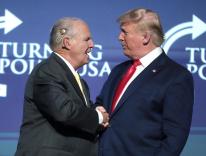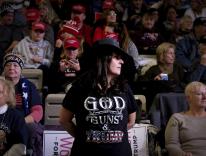In a hopeful but also worrying article published in the April issue of this magazine, Thomas Geoghegan wrote that “as a Catholic, I can take some comfort in the fact that Trump has yet to liquidate the U.S. Catholic Church.” Trump hasn’t absorbed it the way he has conservative white Evangelicals (in a kind of para-Christian political-religious entrepreneurialism), and that is something to be thankful for. But Catholicism hasn’t been totally spared by Trumpism. And there’s little comfort to be gained from the fact that his main opponents in the Catholic political realm—President Biden and Pope Francis—are increasingly at odds over the wars in Ukraine and Israel and Gaza. The other looming concern: What happens after Biden and Francis are no longer on the stage?
The end of the most similar U.S.-Vatican alignment—the presidency of John F. Kennedy and papacy of John XXIII—offers a precedent. In November 1964, Ramparts magazine ran an article titled “The Goldwater/McIntyre Axis.” A cover image showed Republican presidential candidate Barry Goldwater’s head on the body of a rattlesnake, with a caricature of Cardinal James Francis McIntyre, archbishop of Los Angeles from 1948 to 1970, as the tail. “No one can be certain that the Cardinal will vote for the Senator on November 3, but if the tables were reversed, it is quite certain that the Senator would vote for the Cardinal,” concluded Edward M. Keating, the article’s author. Years later, in a 1999 essay, Catholic historian Jeffrey Burns wrote of Keating’s “ten-page rant against the cardinal’s attitude toward race. The depiction of McIntyre as racist and uncaring was patently unfair. His attitude can more accurately be described as obtuse. He simply did not understand the depth of the racial problems in Los Angeles. Nor did he understand the passionate commitment of students and activists who regarded the civil rights issue as the moral issue of the day.” That depiction was unfair, but the article also established just how much had changed in the twelve months following Kennedy’s assassination.
Just over six months out from the 2024 presidential election, it could be said that a “Trump-Strickland” axis may be coming into existence. The “Strickland” (as in Joseph Strickland, deposed bishop of Tyler, Texas) might stand for those quarters of U.S. Catholicism drawn to performances like last month’s Mar-a-Lago prayer event at the former president’s residence, where Trump was presented as “the only Catholic option” for voters. But the “Trump-Strickland” axis isn’t just political. It mixes ahistorical, magisterial fundamentalism in militant Catholicism with nationalistic impulses masquerading as concern for the “forgotten” common American (white) man. So in some sense it does feel like 1963–1964: instead of Vatican II, we have a synodal process with unclear prospects; an aging pope without a clear line of succession for the next conclave; and a presidency that, because of Biden’s age and electoral prospects, feels like it could end without a clear idea of a post-Biden Democratic party. There’s also a sense of the reduced or changing roles of the United States and the Catholic Church on the global stage, as well as the general sense of an end of an era for the Church.
But there are significant differences, too. The “Goldwater-McIntyre axis” suggested a coalescence of conservative concerns and reactionary resistance to change, particularly in regards to civil rights and Vatican II. But neither man flouted the law or social conventions the way Trump and Strickland do. Nor was there an actual alliance between them. The current axis poses greater danger because Strickland apes Trump in promoting a more strident, even violent, representation of conservative/populist concerns. Both basically ignore any authority but their own. Goldwater and McIntyre were more grounded in reality.
The links between Trumpism and certain sectors of Christianity and Catholicism have been subjected to a range of interpretations: Biblical (Romans 13 and obedience to authority); Christological (Trump as anti-Christ); and social-justice oriented (the reversal of the command to love). But an ecclesiological interpretation may shed greater light. Consider Strickland’s media stunt outside the USCCB assembly last November: it was essentially a challenge to the authority and relevance of the conference. Long gone are the days when neo-conservatives felt it a worthy or necessary endeavor to work with the USCCB and the Vatican to influence the final wording of the 1980s pastoral letters on peace and economic justice. Politicization and anti-institutionalism (aided by the development of Catholic ecclesiology of synodality) have created a vacuum. No one pays attention to what the bishops say and do, or what they agree or disagree on; rather, Strickland and clerics like him have rushed to fill the void, asserting themselves and amplifying their message online in very Trumpian fashion.
The Trump-Strickland axis also feeds on the unintended consequences of the post–Vatican II “theology of the laity.” A new breed of what used to be called BCL (“Big Catholic Layman”) has emerged: politically and economically neoliberal, devoted to turbo-capitalism, committed to theological traditionalism but equipped with the lay assertiveness once associated with progressives. The persuasive style that Vatican II envisioned as the key to letting the Church speak in the modern world has succumbed to the raw power of money—a vision of a Church that is funded by those who’ve mastered the rules of the market. The new BCL funds schools and universities, buys media, aggressively lobbies politicians, and exerts influence over judicial appointments; might bishops’ appointments and papal elections be next in their sights? This doesn’t seem so different from what Emperor Constantine, “bishop of those outside,” was able to do, or from the early medieval phenomenon of the Eigentumskirche—the Proprietary Church. It’s hardly the kind of new, emancipated laity we might have expected after the council.
[Editors’ note: With the author’s permission, the editors have removed a paragraph that originally appeared here because Bishop Robert Barron’s media ministry, Word on Fire, informed us that they consider it slander for them to be in any way associated with Donald Trump or Trumpism.]
The second assembly of the Synod on Synodality will gather in October, overlapping with the final weeks of the presidential campaign. Those in the Trump-Strickland axis will likely be focused on the election, not on synodality. And this will probably add to the polarization in U.S Catholicism. “Schism” is the word that sometimes comes up to describe this moment, but it’s not quite right. We actually seem to be in a time like that which preceded the Middle Age era of schisms: the age of heresies prior to the first ecumenical council of Nicaea in 325. For all the talk about Trump being a new Constantine, there is no state or empire limiting or guaranteeing the claims of the Church. If Trumpism has one merit, it’s of having unconsciously dispensed with the religious pretenses and claims of the American nation, as even the conservative Protestant theologian Carl Trueman notes in a column criticizing the Biden administration. American Catholicism is no less involved in this phenomenon. As Michael Hollerich wrote in the introduction to his magisterial book on Eusebius of Caesarea, the biographer of Constantine: “It is sobering to realize how quickly this universal church has, in the United States, made itself small by measuring itself against American Evangelical moralism and nationalism rather than, say, the Large Hadron Collider, my favorite symbol for humanity’s forward movement into the unknown.”
However, at the ecclesiastical and magisterial level, our period resembles the synodomachia (the battles of synods/councils) of the period around and after the council of Nicaea. As once-solid institutions in general are weakening, so are institutional structures within the Church, with the synodal movement challenging the authority of bishops. It’s not clear whether and how synodality might change the way bishops teach and interact with the laity: Will they or won’t they implement whatever changes might come, and how will the laity respond? Meanwhile, the pope and other Vatican hierarchs don’t hold as much sway as they used to with secular governments and seem unable to influence the emerging yet elusive authorities of our globalized world. Also unclear is whether there will even be another general council in global Catholicism. Will the conciliar tradition established with Nicaea and carried on through Vatican II continue into the future? When there are people like Strickland, Viganò, and other Catholic “influencers,” it seems we’ve entered a phase of “wild Christianity” where the key question is not about the undeniable cultural and institutional wilderness we are entering—the absence, collapse, or marginal role of ecclesial and ecclesiastical institutions that have governed Christianity for a millennium. The question is about the Christian character of our responses to the forces unleashed: the new political tyrants like Orbán and Putin, and the “entrepreneurial,” guru-like figures in popular religion who have no academic or ecclesial status but wield influence on militant Catholic clergy and laypeople.
If there is something like a Trump-Strickland axis—and I think there is—it’s not just the product of secularization and religious illiteracy. It’s not the outgrowth of the dogmatization of political ideologies. It’s not the loss of a sacramental imagination, or the rise of unhinged personalities. It arises out of the disappearance of a political-ecclesiastical and theological order. That makes for a far more volatile situation than in 1964, and one more fluid and open perhaps at any time since Christianity’s association with the Roman Empire, which coincided with the creation of an ostensibly universal governing structure, the ecumenical council.
[*] This sentence has been revised after an edit that changed its original intent.
Please email comments to [email protected] and join the conversation on our Facebook page.


